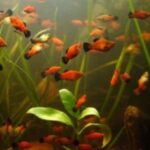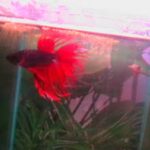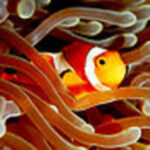Trying to decide the best route to take when stocking a nano tank, which technically covers tanks from a 10 gallons on the small size to 30 gallons at the other end of the spectrum, can be challenging. Questions run rampant from this point on as aquarists are faced with the arduous task of deciding what they plan on maintaining in their aquariums once the aquarium has been purchased. The thought of trying to cram large fish into a nano tank often provides disastrous results. Moreover, overstocking a nano tank or any other marine aquarium often translates into degraded water parameter issues to start. Then comes the question of whether, or not, you plan on adding inverts and corals into your tanks biodiversity. Last but not least and probably the most critical element is the question regarding what fish are exceptional fish that thrive in a downsized marine aquarium. Based on my experience in maintaining nano aquariums, following that up with the many years I have been employed as a specialist at a couple pet shops in their saltwater department, I feel that I can offer newcomers and experts alike three fish species that would make perfect additions to a nano tank.
The countless hours that I have dedicated to research on various fish species through various books written by experts in the marine hobby, have also enabled me to assess what fish are prime subjects for the exciting nano tank.
To start with, Firefish in the family Nemateleotris, represent the pinnacle of nano tank inhabitants. Known for their diminutive size, mild demeanor, hardiness and vibrant coloration, the Firefish affords anyone with a nano tank a suitable and welcome addition. Their are three types of Firefish that you could choose from that vary significantly, price wise. The low end of the spectrum begins with the standard Firefish. For around $15, you could have a pretty fish that displays a white and yellow face continuing to just past its dorsal fin.and front half of its body that succumbs to a red and black back half of its body from its high dorsal fin to Its elongated and somewhat rounded tail. Next comes the Purple Firefish that exemplifies what an awesome small fish should look like, as if Pablo Picasso had thrown some vibrant colors together and created this awe inspiring fish for around $40. This fish displays various colors of purple, white, yellow and red. A cream to white colored body with a hint of yellow around the face region, then transforming to a deep and vibrant red and purple colors along its dorsal, ventral and tail fin region. The last of the Firefish species represents the best of both of these first two Firefish. Known as the Helfrichi Firefish, this fish is the culmination of the Firefish species. A beautiful yellow colored face with a blue area above the eye, succumbs to a vibrant and beautiful deep purple along the body towards the tail where at that point the purple turn to a pastel purple color, that finally gets overshadowed by a creamy white tail with black highlights on the tip of its fins and hints of a subtle blue color mixed in. The price on the Helfrichi Firefish will run you about $100, but well worth its weight in gold based on its rainbow colors, diminutive size and peaceful disposition.
The Firefish remain small ranging in size from 3.5 to 4 inches in length. The intense colors displayed on such a small fish rivals almost any other marine fish in terms of color. These fish will be seen swimming about in the pelagic areas of a tank with rockwork needed as a place to hide and seek protection and feel more at home in its natural element.
The second fish that is well worthy of making its way into a nano tank biotope is the Clown Goby. Clown Gobies only attain an inch to inch and a half in size and for the most part will not venture too far from the benthic areas of your tank. Not containing a swim bladder, these fish will remain in your sand searching for food or perched on your rock and corals as if just watching the world go by and very inquisitive of its outside surroundings. There are four of these Gobies that are commonly encountered in the hobby. The Green, Yellow, Citron and the Panda Gobies work wonders in a nano tank because they add diversity to a tank and fare well with many community fish that are well suited for life in the nano sized aquarium. The colors are not as flashy as those described above with the Firefish, but they add a new dimension of uniqueness that will help to set your tank apart from many others.
The Yellow Clown Goby is just that yellow with a small black eye and a hint of white below the eye. Occasionally you may find one that displays white streaks that run from the eye to the dorsal fin in a perpendicular fashion to its elongated body. The Green Glown Goby is all green with a few reddish streaks along the eye region that fade to blotches of red mixed in with the green color of its body extenuating to the tail. The Citron Goby is the largest of the Clown Gobies at about two inches in size at full grown adult. This fish is yellow in color similar to the Yellow Clown Goby, but with the Citron Goby vibrant streaks of white in the eye and gill regions with another line traveling parallel to the extended dorsal and pelvic fins are evident to differentiate the two species. The Panda Clown Goby is the runt of the species. It has nice contrasting colors in that the overall body is yellow whereas the fins are all brown to black with a hint of red in the gill region. this gem only attains a size of a half inch or so. What this fish lacks in size, it definitely makes up for in its distinct and complementary color display where the black and yellow intermingle very well with the Panda Goby.
last but surely not the least are the Cardinalfish. The three species of Cardinalfish I am referring to are the Banggai, Pajama and the Blue Eye. These fish depict a true nano tank inhabitant due to their size and coloration, moreover, the fact that they are highly visible, seemingly stuck in one part of an aquarium makes these an attractive fish as well. The Banggai cardinal is a classy black and white striped fish with white spots on it body and fin region with a high dorsal fin and extended tail section that almost gives the illusion of having streamers. The Pajama cardinal has the same body style but coloration is different. The coloration of the Pajama cardinal looks like something Picasso could be proud of. The head is a greenish yellow color, that succumbs to deep black outlines of its scales in the middle of its body. The black scale pattern then abruptly changes to reddish brown spots covering the rest of its body. Its fins are translucent with the high dorsal fin and shorter, more compact tail. Its eye is also out of proportion to its body with a vibrant red coloration around it. Its mouth is very large considering the small size of these types of cardinalfish. The Blue Eye cardinalfish is much simpler and laid back colored fish. The entire body is mainly translucent with the exceptions being the notable blue eye and some finely yellow pinstripes around the gill region.
All of these fish do well with flake or frozen foods. They are not finicky eaters and are usually very quick at reacting to food once it hits the water. Parameter issues are the same for many other marine fish in that stable parameters are ideal with little fluctuation in pH, alkalinity, temperature and salinity.
Displaying these in a nano tank as either a single specimen or adding three or more to create a stunning display of color are both considered ideal.
Ofcourse, this does not represent the only nano reef inhabitants, rather, this depicts three of the better suited and easy to maintain fish for a more confined aquarium scenario. These three fish types offer various colors, behavioral traits that are as distinct as they are beautiful.
You will not be disappointed with the possible addition of one or all three of these fish species mentioned above. Versatile, diminutive, distinct and alluring offers these fish a welcome place in your nano tank for years to come.






